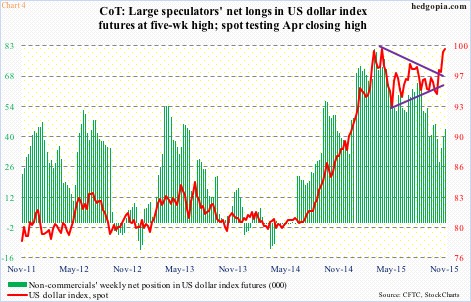Gold bugs should be wishing the U.S. government begins to run larger deficits. There are tons of reasons why the yellow metal has been languishing since it peaked in September 2011, but it turns out it does correlate negatively with the federal government’s budget balance.
Post-Great Recession, the U.S. government began to rack up increasingly large – and larger – budget deficits. The 12-month rolling total peaked in February 2010 at $1.48 trillion. As early as April 2007, this was a tiny – relatively speaking – $145 billion.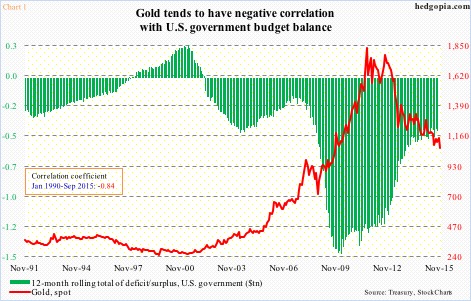
When the green bars in Chart 1 peaked (in February 2010), gold was trading at $1,119/ounce. The latter continued to rally until it peaked in September 2011 at $1,924. The budget deficit by then had shrunk to $1.3 trillion. And it has kept shrinking. Gold keeps making new lows, with shallow rallies in between.
In September, the 12-month rolling total of deficit was nearly $439 billion, gold closed out the month at $1,115. The metal since has dropped further to $1,069.
With the latest drop, gold is sitting on an important level.
Back in July 1999, it made a low of $253, before beginning a multi-year rally. As stated earlier, it peaked in September 2011. The subsequent decline has already retraced 38.2 percent of the 12-year surge. Followers of Fibonacci retracement give special importance to 61.8 percent, which would have occurred if gold were to drop all the way to $891, which, as things stand now, is quite a ways away.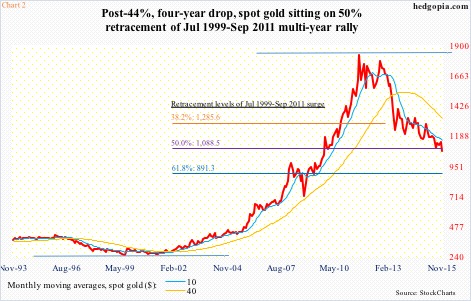
In the meantime, gold has retraced 50 percent of that advance. As a matter of fact, it is literally sitting on that retracement (Chart 2). More often than not, this level tends to provide support. Should that be the case here, a decent bounce/rally can occur.
Gold remains way oversold on a daily basis, and rapidly approaching oversold conditions on a weekly basis. But what are the odds of that happening?
Ever since the metal peaked in September 2011, gold has stopped responding to loose – or ultra loose – monetary policy. In fact, the September 2011 peak occurred shortly after QE2 (U.S.) ended. But gold never got going when QE3 began in September 2012. Even now, both Japan and the Eurozone are in the midst of QE, and China has been aggressively deploying traditional stimulus measures. Gold does not move. Consumer inflation is subdued.
To top it off, the Fed has been sending strong hints that it would like to move as early as December. Higher interest rates do not help gold, particularly so as potential interest-rate differential has given the dollar another tailwind.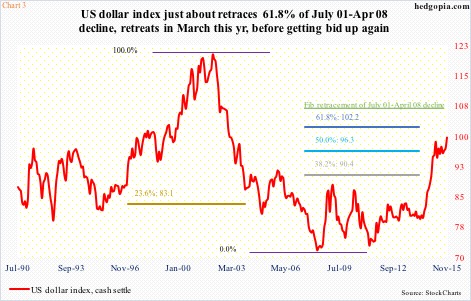
In fact, Chart 3 might hold the key as to if gold succeeds in stabilizing here or takes another leg lower. Between the July 2001-April 2008 decline, the US dollar index dropped 41 percent. The subsequent rally brought it close to retracing nearly 61.8 percent of the afore-mentioned advance in March this year before backing off.
The dollar index has gone parabolic particularly since July last year. After a sideways/slightly down action since that March peak, it has regained momentum. If it continues to rally, will it stop at the 61.8-percent retracement?
They can take solace in the fact that non-commercials are not as aggressive as they were in March when the dollar index peaked. Back then, they were net long 81,270 contracts in US dollar index futures. As of November 10th, they were only net long 43,784 contracts, even though they have been adding in the past three weeks (Chart 4).
That said, price trumps everything, and on this score, the dollar index acts well. Should it continue to attract bids, it is likely spot gold ends up sustainably undercutting the July low. On GLD, the SPDR Gold ETF, the July low was used yesterday as a level to sell/initiate shorts. Rally attempts have persistently been repelled at resistance (Chart 5).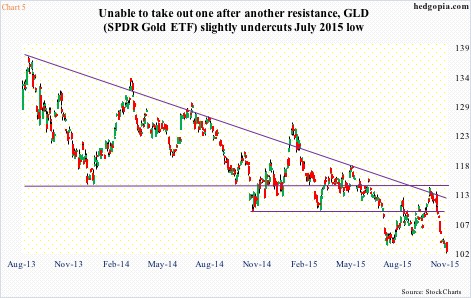
Given how oversold GLD is on a daily chart, it is tempting to at least try selling put spreads or deploy short puts to position to go long at a lower price. But at this point in time, it is still struggling to stabilize, hence worth waiting.
Thanks for reading!

